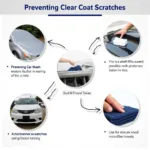Clear coat car paint repair is essential for maintaining your vehicle’s appearance and protecting it from the elements. Scratches, swirl marks, and oxidation can dull your car’s finish, but thankfully, many clear coat issues can be addressed with DIY methods or professional help. This guide will explore various clear coat repair techniques, helping you choose the best approach for your situation.
Protecting your car’s paint is an investment that pays off in the long run. After all, a vibrant, glossy finish enhances the overall aesthetic appeal and can even contribute to a higher resale value. Clear coat, the transparent layer atop your car’s paint, plays a crucial role in this protection. It shields the colored paint from UV rays, environmental contaminants, and minor abrasions. When this layer gets damaged, it’s essential to address the issue promptly to prevent further deterioration. Let’s delve into the world of clear coat car paint repair and understand how to restore your car’s shine. For specific hood repairs, you might find our guide on car clear coat paint damage repair to hood helpful.
Understanding Clear Coat Damage
Clear coat damage can manifest in various forms, each requiring a specific approach. From minor scratches to deep gouges, recognizing the type of damage is the first step towards effective repair. Here’s a breakdown of common clear coat issues:
-
Light Scratches and Swirl Marks: These are often caused by improper washing techniques or minor abrasions. They appear as fine lines or circular patterns on the clear coat surface.
-
Moderate Scratches: These scratches penetrate deeper into the clear coat and are more visible than swirl marks. They can be caused by keys, branches, or other sharp objects.
-
Deep Scratches and Chips: These penetrate through the clear coat and into the base color coat, sometimes even reaching the primer or bare metal. They require more extensive repair methods.
-
Oxidation and Fading: Prolonged exposure to sunlight and environmental pollutants can lead to oxidation, causing the clear coat to appear dull, hazy, or yellowish.
-
Peeling and Cracking: Severe damage or improper application of the clear coat can result in peeling or cracking, often requiring a complete respray. You may want to check out our guide on car paint gouge spot repair cost paint and clear coat.
DIY Clear Coat Repair Methods
For minor clear coat damage like light scratches and swirl marks, DIY methods can be effective and cost-efficient. Here are a few popular options:
-
Rubbing Compound: This abrasive paste can remove fine scratches and restore shine. Apply it with a microfiber cloth using circular motions.
-
Polishing Compound: Less abrasive than rubbing compound, polishing compound further refines the surface and removes any remaining swirl marks. Check our article about car auto coat scratch clear repair paint pen.
-
Clear Coat Scratch Remover: These products are specifically designed for minor clear coat scratches and are generally easier to use than rubbing or polishing compounds.
When to Seek Professional Help
While DIY methods are suitable for minor damage, more extensive issues like deep scratches, chips, oxidation, peeling, or cracking necessitate professional intervention. Professionals have the expertise and equipment to perform more complex repairs, including:
-
Wet Sanding: This technique involves using progressively finer grit sandpaper to level out deep scratches and imperfections.
-
Clear Coat Respray: In cases of severe damage, a complete clear coat respray might be necessary to restore the original finish. Check our guide on car paint clear coat repair.
Preventing Clear Coat Damage
Prevention is always better than cure. Here are some tips to protect your car’s clear coat:
-
Regular Washing and Waxing: Washing your car regularly with the right technique and waxing it every few months provides a protective layer against the elements.
-
Parking in Shade: Protecting your car from direct sunlight can significantly reduce the risk of oxidation and fading.
-
Using a Car Cover: A car cover shields your vehicle from UV rays, dust, and other contaminants. Learn more about car side mirror paint clear coat repair.
Conclusion
Clear coat car paint repair is crucial for maintaining your car’s appearance and value. Understanding the type of damage and choosing the right repair method, whether DIY or professional, can restore your car’s shine and protect it for years to come. Regular maintenance and preventative measures can further extend the life of your clear coat and keep your car looking its best.
FAQ
- Can I repair deep scratches in the clear coat myself? While you can attempt to improve the appearance of deep scratches, a professional repair is often recommended for optimal results.
- How often should I wax my car? Waxing every three to four months is generally sufficient.
- What is the best way to wash my car to prevent clear coat damage? Use the two-bucket method and a microfiber wash mitt.
- Can I apply a clear coat over existing paint? Yes, but the surface needs to be properly prepared.
- How long does clear coat repair take? This depends on the extent of the damage and the repair method used. DIY repairs can take a few hours, while professional repairs may take a day or more.
- How much does professional clear coat repair cost? The cost varies depending on the extent of the damage and the shop’s rates.
- Can clear coat be repaired on plastic bumpers? Yes, similar techniques can be used, but specialized products may be necessary.
For further information, consider exploring topics like car clear coat repair cost or how to repair scratched clear coat on a car.
Need more help? Contact us via WhatsApp: +1(641)206-8880, or Email: cardiagtechworkshop@gmail.com. Our 24/7 customer service team is here to assist you.

